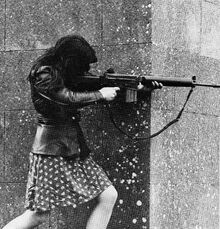
ArmaLite AR-18
The AR-18 is an assault rifle at the Seishou Academy in the Upotte!! anime and manga series.
In Fiction
Appearance
18 looks similar to her cousin 16, since the AR15 and AR18 were both manufactured by Armalite, but 18 has shorter, close-cut hair and does not wear an orange hair ornament.
Looks very similar to AR10.
A trait seen only in the anime, her pants and panties have a tendence of slipping down, referring to a tipical problem of the rifle, a poorly made fixation system of the folding stock, making it wiggle when extended and giving always the impression of unlocking on her own
Personality
While the rifle was designed in the USA and manufactured by Armalite and Sterling armaments, 18 was also manufactured at Howa Machinery Co, making her one of the few native Japanese characters in Upotte. She is very motherly, especially towards Galil. The two became close friends after 18 rescued her in the tournament, since then the two have been inseparable with AR18 being her bestfriend and caretaker.
.One explanation for her motherly nature is that while the AR18 was not adapted by any countries, numerous derivatives such as G36 , Howa Type 89 , SAR 80 , SAR 88 , T2 MK5, T91 and Including Elle, though the two characters are not related.

AR18 and Galil

Female IRA volunteer with her Armalite.
In Real Life
History
The AR-18 was developed by Arthur Miller of the Armalite company as a competitor to the AR-15, aiming for the international military market, especially third world countries. The AR-18 was a really successful design from a technical standpoint and it could be made at much lower cost and on simplified machinery, but it come out too late to compete with both the officially accepted and adopted M16 and the already widespread Soviet AK-47.
The manufacturing license was sold to the British company Sterling Armaments and to the Japanese company Howa Machinery, but even so less than 20.000 were made in total. In 1983 ArmaLite was sold to Elisco Tool Manufacturing Company, of the Philippines. The AR-18 tooling at the Costa Mesa shop went to the Philippines, while some of the remaining ArmaLite employees acquired the remaining inventory of parts for the AR-17 and AR-18.
Elisco Tool had successfully produced the M16A1 for the Philippine armed forces and police. Difficulties with Colt over M16 licensing prompted Elisco to seek another 5.56mm rifle, and the AR-18 was the only real contender. Inventory, tooling, and machinery were therefore dispatched from Sterling’s plant to the Philippines.
Marcos selected the AR-18 as the new replacement service rifle for the AFP/PC, as it was the most similar to the now prohibitively expensive to produce M-16. The plant was about to go into mass-production when the (in)famous EDSA Revolution happened. Well... the rest, as they say, is history. The process fell apart not in the U.S. market, but because of political events in the Philippines themselves. In short, Ferdinand Marcos was overturned and went into exile. The political and economic links of the government were dramatically shifted, and Elisco was unable to carry out the AR-18 production. The U.S. arm of the operation was closed in 1987. As with all Marcos initiatives, whether good or bad for the country, the Elisco Tool & Mfg company was "abandoned" by the Philippine government, and the production of the AR-18's for the AFP was completely halted along with the contract, which was cancelled.
Left hanging in the air, all the Elisco company could do was close shop and sell Armalite to a consortium back in the United States(the company that bought Armalite still owns it to this day).
. In 2001 the ArmaLite (Eagle Arms) company resurrected the AR-18 under the AR-180B version, intended mostly for the civilian and law enforcement markets, the stamped steel lower receiver was replaced with a plastic one, also the new model now accepts AR-15 magazines and features an AR-15-type trigger unit, which allowed for wider spare parts availability. The original folding buttstock were replaced with the plastic fixed buttstock, though an aftermarket adapter is available. ,

An AR-18 bullpup conversion made during the development of the L64.
Even when the AR-18 was considered a commercial failure, several other firearm manufacturers used the design as a base for their own weapons platforms including the British L85A1 bull-pup assault rifle, the Singapore SAR-80, the Australian Bushmaster M17S, the Japanese Howa Type 89 and the German H&K G36.
Users
The AR-18 even loaned to the JSDF wasn't officially adopted by any nation as a standard service rifle. The AR 18 was an export option of suppying more guns to the United States allies or friends without selling the still hot M16. The AR-180 was sold on the civilian market, while the AR-18 sold in small quantities to police and law enforcement organizations. The rifle got some popularity in the hands of the Provisional IRA who obtained it from the United States in the early 1970s and was an emotive symbol of its armed campaign, sometimes under the nickname "Widowmaker".
Was to replace The M16A1 in the Philippines as the new service rifle In the 80's but was cancelled after Elisco Tools and Armalite Philippines was abandoned by the Government after The Bloodless revolution.

AR-180, note the plastic fixed buttstock.
Performance
The AR-18 suffered various malfunctions during evaluation trials by various nations those including the United States and the United Kingdom. During the US trials the AR-18's functioning was found to vary from lot to lot of ammunition and the evaluating board concluded that the AR-18 required additional minor revisions and changes before it could be considered for adoption as a service rifle. The British Ministry of Defense found the design unsatisfactory in performance during mud and sand trials. The rifle was also known for a loose folding stock, something prone to happen after extensive use.
Armalite made several minor production modifications to the design commencing in 1965, however, American procurement officials were not interested in acquiring yet another 5.56 mm service rifle.
